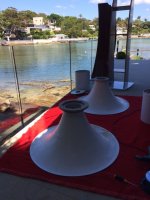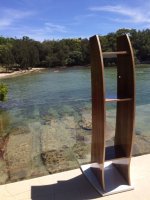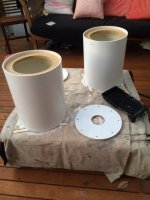Just finishing off this new 4-way, which features:
Azura 160Hz mid bass horn with 8 inch B&C 8PE21 pro driver (98dB)
Azura 340Hz mid horn, 2 inch throat, with JBL 2445 drivers (new Radian diaphragms)
Azura 550Hz tweeter horn, 1 inch throat, with JBL 2420 drivers (new Radian diaphragms)
Faital Pro 18-inch sub bass in one inch Birch Ply/Walnut sealed boxes, heavily braced, 23 inch x 23 x 23
4x10 MiniDSP, but will be adding quality passive for the 3 horns later.
Mix of amps, including 845 SET, Nelson Pass First Watt F5, and a pro Yamaha amp for bass.
Stands CNC’d in ¾ inch matching Birch/Walnut. Plinth in 1 inch MDF, gloss white two pack poly. Stands in gloss two pack clear poly.
Pretty big sound….waiting for more readings, pics etc.
This system can be built from a flat pack kit quite easily.
Azura 160Hz mid bass horn with 8 inch B&C 8PE21 pro driver (98dB)
Azura 340Hz mid horn, 2 inch throat, with JBL 2445 drivers (new Radian diaphragms)
Azura 550Hz tweeter horn, 1 inch throat, with JBL 2420 drivers (new Radian diaphragms)
Faital Pro 18-inch sub bass in one inch Birch Ply/Walnut sealed boxes, heavily braced, 23 inch x 23 x 23
4x10 MiniDSP, but will be adding quality passive for the 3 horns later.
Mix of amps, including 845 SET, Nelson Pass First Watt F5, and a pro Yamaha amp for bass.
Stands CNC’d in ¾ inch matching Birch/Walnut. Plinth in 1 inch MDF, gloss white two pack poly. Stands in gloss two pack clear poly.
Pretty big sound….waiting for more readings, pics etc.
This system can be built from a flat pack kit quite easily.
Attachments
-
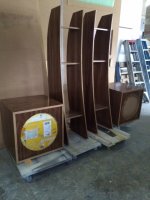 IMG_0390 2.jpg90.2 KB · Views: 1,122
IMG_0390 2.jpg90.2 KB · Views: 1,122 -
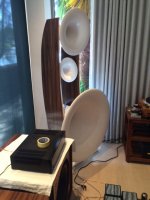 trio in room.jpg89.1 KB · Views: 410
trio in room.jpg89.1 KB · Views: 410 -
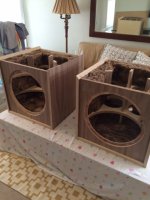 post-103876-0-29292300-1415871030.jpg114.6 KB · Views: 507
post-103876-0-29292300-1415871030.jpg114.6 KB · Views: 507 -
 post-103876-0-71197700-1417252017.jpg93.6 KB · Views: 1,069
post-103876-0-71197700-1417252017.jpg93.6 KB · Views: 1,069 -
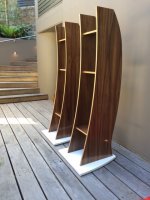 stands and base.jpg120.8 KB · Views: 1,068
stands and base.jpg120.8 KB · Views: 1,068 -
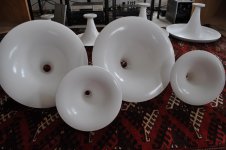 Azura horns.jpg171.7 KB · Views: 1,089
Azura horns.jpg171.7 KB · Views: 1,089 -
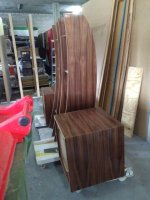 IMG_0391 4.jpg101.7 KB · Views: 1,084
IMG_0391 4.jpg101.7 KB · Views: 1,084
A few more pics, inlcuding my outdoor 'workstation.'
Chamber for the 160 horn is 300mm PVC piping with pre-cut MDF rings inside for housing the horn flange and rear panel.
Chamber for the 160 horn is 300mm PVC piping with pre-cut MDF rings inside for housing the horn flange and rear panel.
Attachments
The speakers look great and the outdoor work station looks pretty good too.. The stands are very cool looking.
Looking forward to hearing more technical detail soon.
Looking forward to hearing more technical detail soon.
Thanks. The stands were curved that way to aim for driver alignment.The speakers look great and the outdoor work station looks pretty good too.. The stands are very cool looking.
Looking forward to hearing more technical detail soon.
The stands were curved that way to aim for driver alignment.
With a digital source it is easy to create precise digital delays for driver time alignment such that all horn mouth exits could align in one plane.
Your photos show your selection of analog turntable plus tube amps. Have you ever considered an all-pass analog analog(tube or JFET) delay circuit as an alternative to physical horn driver alignment? Have you ever considered (tube or JFET) analog crossover filters as an alternative to passive LRC?
Linkwitz (linkwitzlab.com) made solid state opamp all-pass delay circuits popular, along with researching complex analog xover circuits --- before the digital solutions became cheap. I don't see too many horn+tube folks using MiniDSP tech, but a couple good quality analog opamp filters could improve and/or simplify a multi-horn setup.
Thanks for your sound advice. I have a friend who's helping with xovers....he's done some good work on previous horns...and uses a mix of tried and tested mic/recordings, plus relevant xover modelling software. I'll certainly look further into the Linkwitz options and other analogue opportunities.With a digital source it is easy to create precise digital delays for driver time alignment such that all horn mouth exits could align in one plane.
Your photos show your selection of analog turntable plus tube amps. Have you ever considered an all-pass analog analog(tube or JFET) delay circuit as an alternative to physical horn driver alignment? Have you ever considered (tube or JFET) analog crossover filters as an alternative to passive LRC?
Linkwitz (linkwitzlab.com) made solid state opamp all-pass delay circuits popular, along with researching complex analog xover circuits --- before the digital solutions became cheap. I don't see too many horn+tube folks using MiniDSP tech, but a couple good quality analog opamp filters could improve and/or simplify a multi-horn setup.
I know MiniDSP, valves, horns etc is an odd combination...but there's a convenience factor also. For $500, it was a sensible choice for starting the project off.
I've been debating the same issue recently as I have been using all tube electronics with horns for over a decade. The advantages of dsp for driver time alignment, xo, and room correction seem compelling at the expense of considerable additional complexity, and there are some of us who are loath (perhaps irrationally) to mix tube and solid state in the signal path because of concerns over loss of transparency, etc. (I'm not a total luddite though I do for example have Sony HAP-Z1ES and 777ES sources, and two all tube analog signal chains for my turntables.) I have long suffered the interactions of high source impedance SE amps with speakers and XO, so eliminating some of those interactions could be a win..
"With a digital source it is easy to create precise digital delays for driver time alignment such that all horn mouth exits could align in one plane."
Throat or mouth exits to align in one plane?
Throat or mouth exits to align in one plane?
Throats align in the time domain (actually, the acoustic center of each driver). Mouths can align physically using digital delays.
Last edited:
Just use better quality digital crossovers having better analog sections to avoid SQ issues. In practice, these units don't have "considerable additional complexity", in fact I find them to be much simpler in practice to dial in everything.The advantages of dsp for driver time alignment, xo, and room correction seem compelling at the expense of considerable additional complexity, and there are some of us who are loath (perhaps irrationally) to mix tube and solid state in the signal path because of concerns over loss of transparency, etc...I have long suffered the interactions of high source impedance SE amps with speakers and XO, so eliminating some of those interactions could be a win..
The good thing is that digital crossovers can be reused over and over again so your investment can stretch over a long DIY series of loudspeakers/configurations. In fact, this saves a fair amount of money if you plan on doing DIY a lot or even just a series of setup upgrades.
I've found that better quality digital crossovers can be had in good condition in places like craigslist and ebay for 2/3 or more off of new price. I currently own three units that I use in my 5.2 system to correct for horn-loaded delays, to do crossover duties, and EQ. I plan on acquiring at least one more for testing and setup of new loudspeakers in the workshop area.
My experience is actually limited to EV and Yamaha (first-hand) but I've also heard good info with Ashly Protea. Tom Danley recommends Xilica, (thread here). There are a fair number of manufacturers.
I'd check into manufacturers that you like, then look for the exact configuration that you need. If you're doing two-channel only, then 2-in, 6-out is usually a good configuration.
I do recommend a unit that uses 96 kHz sampling frequency. The Yamaha SP2060 sounds a great deal better than the EV Dx38s: the major difference is 48 vs. 96 kHz internal sampling rate. Other considerations include looking out for electrolytic caps in the signal path and looking at the exact ADCs and DACs by manufacturer used in the unit (e.g., Burr-Brown, etc.).
Chris
I'd check into manufacturers that you like, then look for the exact configuration that you need. If you're doing two-channel only, then 2-in, 6-out is usually a good configuration.
I do recommend a unit that uses 96 kHz sampling frequency. The Yamaha SP2060 sounds a great deal better than the EV Dx38s: the major difference is 48 vs. 96 kHz internal sampling rate. Other considerations include looking out for electrolytic caps in the signal path and looking at the exact ADCs and DACs by manufacturer used in the unit (e.g., Burr-Brown, etc.).
Chris
Very cool system. How do you mount the horns to the stands?
For the bass horn, I've used a 300mm diameter PVC pipe, which fitted snug. I'm replacing this with CNC'd MDF rings, to form a solid chamber. I'll the. Decide to replicate this approach for the top two horns. Until then, they're just resting on foam mat with a simple plastic tie. With the MDF rings, I can then paint all together to match.
This is a fantastic project and by all means should sound wonderful! Looking forward to more updates.
Paul
Paul
A good test question for analog vs. digital crossover decision:
If you use a miniDSP crossover, "Will you convert all your vinyl records to digital computer files?
If there is no magic in an all analog system, then convert your records to digital files and retire your Turn Table. Stop purchasing records, since miniDSP will only convert them to vinyl limited BW digital anyway.
The movies use the phrase: "I am an analog guy in a digital world."
If you use a miniDSP crossover, "Will you convert all your vinyl records to digital computer files?
If there is no magic in an all analog system, then convert your records to digital files and retire your Turn Table. Stop purchasing records, since miniDSP will only convert them to vinyl limited BW digital anyway.
The movies use the phrase: "I am an analog guy in a digital world."
perhaps. A friend recently mentioned this, citing a comparison between a vinyl track on Pink Floyd Dark Side of the Moon. The vinyl blew the cd away with extra bass depth. I'm not sure if you could accurately record this to digital to get the same result.A good test question for analog vs. digital crossover decision:
If you use a miniDSP crossover, "Will you convert all your vinyl records to digital computer files?
If there is no magic in an all analog system, then convert your records to digital files and retire your Turn Table. Stop purchasing records, since miniDSP will only convert them to vinyl limited BW digital anyway.
The movies use the phrase: "I am an analog guy in a digital world."
OT: Your thread revisits a question many on diyAudio have/will face.
Is there magic in an all analog system?
Is there magic in an all 24b/96Khz digital system?
Pink Floyd's album, Dark Side of the Moon was recorded on a 16 track analog tape recorder at Abbey Road studios in 1973, and this tape was used to create both early 16b /44Khz Sony PCM digital CD transfer, and later 2003 24bit 96khz SACD and recent 2011 BluRay and FLAC.
From web discussions, I suspect 24b/96KHz Floyd FLAC on all 24b/96KHz digital path to the final amplifiers would win a vote.
MEDIA CONTROLS EVERYTHING.
Investments in Vinyl, Turntables, and tubes is the natural foundation to all-analog systems.
Investments in a music server is the natural foundation to all 24b/96kHz digital system.
Will your next media purchase be Vinyl or High-Def digital?
======
Analog LP records have a SNR of approximately 50 to 60 dB, with a theoretical max of 70db.
The SNR of the CD-DA is 96 dB.
The SNR of the DVD-A is 108 db.
The SNR of the SACD-DA is 120 dB.
The SNR of the 24b / 96Khz FLAC is is 144 dB.
Only the best front ends and amplifiers can achieve SNR = 120db at even half rated power.
Is there magic in an all analog system?
Is there magic in an all 24b/96Khz digital system?
A friend recently mentioned this, citing a comparison between a vinyl track on Pink Floyd Dark Side of the Moon. The vinyl
blew the cd away with extra bass depth. I'm not sure if you could accurately record this to digital to get the same result.
Pink Floyd's album, Dark Side of the Moon was recorded on a 16 track analog tape recorder at Abbey Road studios in 1973, and this tape was used to create both early 16b /44Khz Sony PCM digital CD transfer, and later 2003 24bit 96khz SACD and recent 2011 BluRay and FLAC.
From web discussions, I suspect 24b/96KHz Floyd FLAC on all 24b/96KHz digital path to the final amplifiers would win a vote.
MEDIA CONTROLS EVERYTHING.
Investments in Vinyl, Turntables, and tubes is the natural foundation to all-analog systems.
Investments in a music server is the natural foundation to all 24b/96kHz digital system.
Will your next media purchase be Vinyl or High-Def digital?
======
Analog LP records have a SNR of approximately 50 to 60 dB, with a theoretical max of 70db.
The SNR of the CD-DA is 96 dB.
The SNR of the DVD-A is 108 db.
The SNR of the SACD-DA is 120 dB.
The SNR of the 24b / 96Khz FLAC is is 144 dB.
Only the best front ends and amplifiers can achieve SNR = 120db at even half rated power.
If we have the opportunity to align physically, why even think about delaying digitally? To me it makes far more sense for this amount of real estate to stay as much in the "unprocessed" domain as possible.
Such well behaved horn/drivers don't even really need dsp. Simple 6dB/8va crossovers yield outstanding results. They can be implemented passively in the amplifiers!
Such well behaved horn/drivers don't even really need dsp. Simple 6dB/8va crossovers yield outstanding results. They can be implemented passively in the amplifiers!
Usually due to diffraction from horn bodies.If we have the opportunity to align physically, why even think about delaying digitally? To me it makes far more sense for this amount of real estate to stay as much in the "unprocessed" domain as possible.
- Status
- Not open for further replies.
- Home
- Loudspeakers
- Multi-Way
- Pics - new 4 way horn system, Azura
